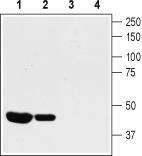Kv1.8 (KCNA10) Rabbit Polyclonal Antibody
Other products for "KCNA10"
Specifications
| Product Data | |
| Applications | WB |
| Recommended Dilution | WB: 1:200-1:2000 |
| Reactivities | Human, Mouse, Rat |
| Host | Rabbit |
| Clonality | Polyclonal |
| Immunogen | Peptide (C)KDPETLLPTNDIHCR, corresponding to amino acid residues 187- 200 of human KV1.8. Intracellular, N-terminus. |
| Formulation | Lyophilized. Concentration before lyophilization ~0.8mg/ml (lot dependent, please refer to CoA along with shipment for actual concentration). Buffer before lyophilization: Phosphate buffered saline (PBS), pH 7.4, 1 % BSA, 0.025% NaN3. |
| Purification | Affinity purified on immobilized antigen. |
| Conjugation | Unconjugated |
| Storage | Store at -20°C as received. |
| Stability | Stable for 12 months from date of receipt. |
| Gene Name | potassium voltage-gated channel subfamily A member 10 |
| Database Link | |
| Background | Potassium (K+) channels regulate cell membrane potential and modulate a number of important cellular functions. K+ voltage-gated channel subfamily A member 10 (KCNA10) also known as KV1.8 is a voltage-gated K+ (KV) channel gene related to the Shaker family of K+ channels that includes eight members (KV1.1- KV1.8). KV1.8 contains six membrane-spanning domains with a shaker-type repeat in the fourth segment and a pore (P) region. Its most distinguishing feature is the presence of a putative cyclic nucleotide-binding (CNB) domain at the COOH terminus. It is specifically regulated by cGMP and postulated to mediate the effects of substances that increase intracellular cGMP. The channel displays an unusual inhibitor profile, because in addition to being blocked by classical K+ channel blockers, it is also sensitive to inhibitors of cyclic nucleotide gated cation channel such as verapamil and pimozide. KV1.8 is detected in kidney, heart, and aorta by Northern blot and postulated to participate in renal K+ metabolism and to regulate vascular tone. A recent study showed that a mutation of mouse KCNA10 causes significant vestibular and mild hearing dysfunction. In addition KCNA10 has been associated with Long QT syndrome (LQTS), an arrhythmogenic disorder characterized by prolongation of the QT interval on electrocardiograms (ECGs). |
| Synonyms | Kcn1; Kv1.8 |
| Reference Data | |
| Protein Families | Druggable Genome, Ion Channels: Potassium, Transmembrane |
Documents
| Product Manuals |
| FAQs |
{0} Product Review(s)
0 Product Review(s)
Submit review
Be the first one to submit a review
Product Citations
*Delivery time may vary from web posted schedule. Occasional delays may occur due to unforeseen
complexities in the preparation of your product. International customers may expect an additional 1-2 weeks
in shipping.






























































































































































































































































 Germany
Germany
 Japan
Japan
 United Kingdom
United Kingdom
 China
China



